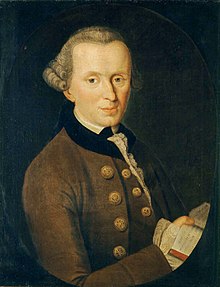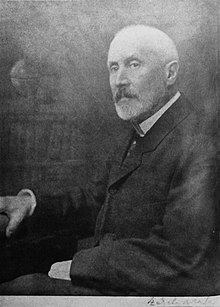Hermann Ludwig Ferdinand von Helmholtz[a] (31 August 1821 – 8 September 1894) was a German physicist and physician who made significant contributions in several scientific fields. The largest German association of research institutions, the Helmholtz Association, is named after him.[5]
In physiology and psychology, he is known for his mathematics of the eye, theories of vision, ideas on the visual perception of space, color vision research, and on the sensation of tone, perception of sound, and empiricism in the physiology of perception.
In physics, he is known for his theories on the conservation of energy, work in electrodynamics, chemical thermodynamics, and on a mechanical foundation of thermodynamics.
As a philosopher, he is known for his philosophy of science, ideas on the relation between the laws of perception and the laws of nature, the science of aesthetics, and ideas on the civilizing power of science.
Hermann von Helmholtz | |
|---|---|
 | |
| Born | Hermann Ludwig Ferdinand Helmholtz 31 August 1821 |
| Died | 8 September 1894 (aged 73) |
| Education | Medicinisch-chirurgisches Friedrich-Wilhelm-Institut (M.D., 1842) |
| Known for | |
| Spouse(s) | Anna von Helmholtz |
| Awards |
|
| Scientific career | |
| Fields | |
| Institutions | |
| Thesis | De fabrica systematis nervosi evertebratorum (1842) |
| Doctoral advisor | Johannes Peter Müller |
| Doctoral students | |
| Other notable students | |
| Influences | |
| Influenced | Friedrich Albert Lange[3] Ludwig Wittgenstein[4] |
https://en.wikipedia.org/wiki/Hermann_von_Helmholtz
Ludwig Josef Johann Wittgenstein (/ˈvɪtɡənʃtaɪn, -staɪn/ VIT-gən-s(h)tyne;[14]German: [ˈluːtvɪç joˈhan ˈjoːzɛf ˈvɪtɡn̩ʃtaɪn]; 26 April 1889 – 29 April 1951) was an Austrian-British philosopher who worked primarily in logic, the philosophy of mathematics, the philosophy of mind, and the philosophy of language.[15] He is considered to be one of the greatest philosophers of the 20th century.[16]
Ludwig Wittgenstein | |
|---|---|
 Portrait of Wittgenstein on being awarded a scholarship from Trinity College, Cambridge, 1929 |
https://en.wikipedia.org/wiki/Ludwig_Wittgenstein
Rudolf Hermann Lotze (/ˈlɔːtsə/; German: [ˈlɔtsə]; 21 May 1817 – 1 July 1881) was a German philosopher and logician. He also had a medical degree and was well versed in biology. He argued that if the physical world is governed by mechanical laws, relations and developments in the universe could be explained as the functioning of a world mind. His medical studies were pioneering works in scientific psychology.
Hermann Lotze | |
|---|---|
 |
https://en.wikipedia.org/wiki/Hermann_Lotze
Immanuel Kant (UK: /kænt/,[20][21] US: /kɑːnt/,[22][23] German: [ɪˈmaːnu̯eːl ˈkant, -nu̯ɛl -];[24][25] 22 April 1724 – 12 February 1804) was a German philosopher and one of the central Enlightenment thinkers.[26][27] Kant's comprehensive and systematic works in epistemology, metaphysics, ethics, and aesthetics have made him one of the most influential figures in modern Western philosophy.[26][28]
Immanuel Kant | |
|---|---|
 Portrait by Johann Gottlieb Becker, 1768 |
https://en.wikipedia.org/wiki/Immanuel_Kant
Johann Gottlieb Fichte (/ˈfɪxtə/;[28] German: [ˈjoːhan ˈɡɔtliːp ˈfɪçtə];[29][30][31] 19 May 1762 – 29 January 1814) was a German philosopher who became a founding figure of the philosophical movement known as German idealism, which developed from the theoretical and ethical writings of Immanuel Kant.
Johann Gottlieb Fichte | |
|---|---|
 |
https://en.wikipedia.org/wiki/Johann_Gottlieb_Fichte
Wilhelm Maximilian Wundt (/vʊnt/; German: [vʊnt]; 16 August 1832 – 31 August 1920) was a German physiologist, philosopher, and professor, known today as one of the founders of modern psychology. Wundt, who distinguished psychology as a sciencefrom philosophy and biology, was the first person ever to call himself a psychologist.[1]He is widely regarded as the "father of experimental psychology".[2][3]
Wilhelm Wundt | |
|---|---|
 Wilhelm Wundt in 1902 |
https://en.wikipedia.org/wiki/Wilhelm_Wundt
Henry Augustus Rowland FRS(For) HFRSE (November 27, 1848 – April 16, 1901) was an American physicist and Johns Hopkins educator. Between 1899 and 1901 he served as the first president of the American Physical Society. He is remembered primarily for the high quality of the diffraction gratings he made and for the work he did with them on the solar spectrum.
Henry Augustus Rowland | |
|---|---|
 | |
| Born | November 27, 1848 Honesdale, Pennsylvania, U.S. |
| Died | April 16, 1901 (aged 52) |
https://en.wikipedia.org/wiki/Henry_Augustus_Rowland
https://en.wikipedia.org/wiki/Diffraction_grating
Arthur Gordon Webster (November 28, 1863 – May 15, 1923) was an American physicist who founded the American Physical Society.
Arthur Webster | |
|---|---|
 Webster c. 1915 |
https://en.wikipedia.org/wiki/Arthur_Gordon_Webster
Otto Richard Lummer (17 July 1860 – 5 July 1925) was a German physicist and researcher.[1] He was born in the city of Gera, Germany. With Leon Arons, Lummer helped to design and build the Arons–Lummer mercury-vapor lamp.[2] Lummer primarily worked in the field of optics and thermal radiation. Lummer's findings, along with others, on black body radiators led Max Planck to reconcile his earlier Planck's law of black-body radiation by introducing the quantum hypothesis in 1900.[3] In 1903, with Ernst Gehrcke, he developed the Lummer–Gehrcke interferometer. Lummer died in former Breslau, now Wrocław.
https://en.wikipedia.org/wiki/Otto_Lummer
Wilhelm Carl Werner Otto Fritz Franz Wien (German: [ˈviːn]; 13 January 1864 – 30 August 1928) was a German physicist who, in 1893, used theories about heat and electromagnetism to deduce Wien's displacement law, which calculates the emissionof a blackbody at any temperature from the emission at any one reference temperature.
He also formulated an expression for the black-body radiation, which is correct in the photon-gas limit. His arguments were based on the notion of adiabatic invariance, and were instrumental for the formulation of quantum mechanics. Wien received the 1911 Nobel Prize for his work on heat radiation.
He was a cousin of Max Wien, inventor of the Wien bridge.
https://en.wikipedia.org/wiki/Wilhelm_Wien
Johannes Peter Müller (14 July 1801 – 28 April 1858) was a German physiologist, comparative anatomist, ichthyologist, and herpetologist, known not only for his discoveries but also for his ability to synthesize knowledge. The paramesonephric duct(Mullerian duct) was named in his honor.
https://en.wikipedia.org/wiki/Johannes_Peter_Müller
Johannes Adolf von Kries (6 October 1853, Roggenhausen – 30 December 1928, Freiburg im Breisgau) was a German physiological psychologist[1] who formulated the modern “duplicity” or “duplexity” theory of vision mediated by rod cells at low light levels and three types of cone cells at higher light levels.[2][3] He made important contributions in the field of haemodynamics.[4] In addition, von Kries was a significant theorist of the foundations of probability.
https://en.wikipedia.org/wiki/Johannes_von_Kries
Baron Loránd Eötvös de Vásárosnamény (or Loránd Eötvös, pronounced [ˈloraːnd ˈøtvøʃ], Hungarian: vásárosnaményi báró Eötvös Loránd Ágoston; 27 July 1848 – 8 April 1919), also called Baron Roland von Eötvös in English literature,[2] was a Hungarian physicist. He is remembered today largely for his work on gravitation and surface tension, and the invention of the torsion pendulum.
In addition to Eötvös Loránd University[3] and the Eötvös Loránd Institute of Geophysics in Hungary, the Eötvös crater on the Moon,[4] the asteroid 12301 Eötvösand the mineral lorándite also bear his name.
Loránd Eötvös | |
|---|---|
 Eötvös in 1912 |
https://en.wikipedia.org/wiki/Loránd_Eötvös
No comments:
Post a Comment